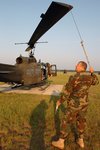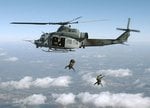syscom3
Pacific Historian
The distinctive "chop-chop-chop" was always great to hear!
The National Guard - Huey's last hurrah
Huey's last hurrah
By Sgt. Benjamin Cossel
196 Mobile Public Affairs Detachment, Columbus, Ohio
CAMP GRAYLING, Mich. (7/2/2007) - As you go about your daily routine during annual training this year and the familiar "womp-womp-womp" sounds of helicopters fill the air, stop for a moment and turn your head toward the sky. Scattered amongst the Blackhawks, Chinooks and Kiowas buzzing about you'll notice two UH-1H Iroquois reliably doing what they've done for more than 35 years.
Hollywood's infatuation with the Iroquois, known in common vernacular as the Huey, and exemplified in such movies as "Apocalypse Now" and "We Were Soldiers," has planted the image of the Huey as firmly in the American psyche as the tank and the M-16 rifle. As the sun sets on AT 2007, so too, will that iconic image of Army aviation take its final ride for the Ohio Army National Guard.
"The Huey is what's called legacy technology," said Col. Rick Hall, the state Army aviation officer for Ohio.
"It doesn't have redundant systems, it doesn't have near the lift capability of the modern aircraft, it doesn't have enough range and it doesn't do as well in a crash as modern aircraft," Hall said.
Hall explained that the Army has been in the process of phasing out the Huey for several years but that Ohio resisted releasing their Hueys for as long as possible. "The state doesn't have enough Blackhawks, so frankly, we've used the Hueys to fill out our fleet."
Hall estimates that at their peak, the Hueys numbered about 120 in service, now only two fly with Company B, 1st Battalion, 137th Aviation Regiment.
"It'll be a sad, sad day when these birds finally go away," said Columbus, Ohio resident Sgt. 1st Class Robert Baker, a Huey mechanic with Company B.
With 33 years in the military, all in the aviation field, Baker has worked on nearly every aircraft fielded since his days as a private.
"The Huey is dependable and fun - you just don't have to worry about it, it's a mechanically sound aircraft," Baker said.
Besides being reliable, he said there was no other aircraft he preferred flying more. "You could just throw open the doors and see the whole world," Baker said. That sentiment apparently filled others as people constantly stopped Baker to ask for rides in the Huey.
"We've taken so many people up in this aircraft. VIP's, governors, even General Kambic [Brig. Gen. Matthew Kambic, Ohio's assistant adjutant general for Army] loved it. So many people have gone up in the Huey and they all just love it."
With the end of his flying days in the Hueys looming near, chief warrant officer Brian Michael, a pilot with Company B maintains a pragmatic attitude.
"I'll be a little sad to see them go, but they've served their purpose. Time to move on to bigger, better and faster aircraft," Michael said.
After having flown Huey missions in the jungles of Vietnam, Michael seems the perfect choice to fly these aircraft in their final days. During annual training the Huey has been used for Bambi bucket operations, range sweep and medevac missions, but Michael remembers well when the Huey was the king of the air during the Vietnam War.
"The Huey was the perfect aircraft for the mission in Vietnam," said the Columbus, Ohio based Michael.
Michael stops to consider all the different missions he's flown in the Huey;
rescue operations during the blizzard of 1978 in northern Ohio, casualty evacuation and resupply operations during mudslides in north-central Ohio in 1989.
"Those state operations, the ones where we were actually helping people, saving lives, those were some of the best," Michael said.
Heading out to the flight line, pilot and crew chiefs alike prepared the Huey for one in the a list of missions. Near the second week of August, the two remaining Hueys will be released from the Ohio Army National Guard, transferred to their new homes.
One of the Hueys will go to the Colorado National Guard to continue service, the other will go to Texas where it will be refurbished for foreign sales.
"I'd keep those Hueys for another two years if I could," said Hall. "It'll definitely be a sad day when we finally let them go."


 They were the best choppers I've ever read about.
They were the best choppers I've ever read about.